Last updated on October 2nd, 2024
Featured image: Coastal views of San Sebastian in the Basque region of Spain | Photo by Unai82 on Envato
Exploring the region’s unique culture, food and heritage in northern Spain and southern France
by Karen Gershowitz
The Basque region, straddling northern Spain and southern France, is an area often forgotten by travellers to Spain. I’ve visited Spain many times, but this was my first excursion into the area. I wish I’d come sooner; from the moment I arrived, I fell in love with its cultural richness, natural beauty, and food.
Get stories just like this delivered straight to your inbox! Join us here.
The Basque region: fiercely independent
As I discovered when talking with a tour guide, shopkeepers and hotel staff, the Basque people are proud of their history and have a fiercely independent spirit. They are one of the oldest ethnic groups in Europe. Their language, Euskara, predates other European languages and is distinct from any other known language family. Most students in the region are bilingual, with Basque being their primary language and the language taught in schools.
In the modern era, the Basque Country has been a site of both industrial prosperity and political turmoil. The Spanish portion became highly industrialized in the 19th and 20th centuries, leading to significant economic growth. However, the twentieth century also saw the rise of Basque nationalism. The Franco dictatorship sought to suppress regional languages and cultures. In response, the ETA, a militant Basque separatist group developed. It engaged in a violent campaign for independence throughout the latter half of the century. In contrast, the French Basque region remained more rural and less industrialized, with its nationalist movement taking a less violent and more cultural-focused approach. Today, both regions have a reputation for their powerful sense of identity and their efforts to preserve cultural traditions.
Bilbao: A blend of modernity and tradition
With a population of about 350,000, Bilbao is the largest Basque city in Spain. I have wanted to visit Bilbao ever since the Guggenheim Museum Bilbao opened in 1997. The museum is a striking example of how contemporary architecture can play a pivotal role in the economic revitalization of a city. Bilbao had been suffering from an economic downturn. The Guggenheim’s construction marked the beginning of the “Bilbao Effect,” a term used to describe how a single, landmark cultural investment can transform the fortunes of a city. Known for its innovative design, the museum quickly became an iconic symbol of Bilbao. The Guggenheim has since attracted millions of visitors, significantly boosting tourism, spurring urban renewal, and revitalizing the local economy. It has turned Bilbao from an aging industrial city into a cultural destination.
The building is a masterpiece, with curving lines and shimmering surfaces that change with the light. I spent many hours there. Both outside and in, Frank Gehry’s architecture is captivating. Over the years, I’ve seen his buildings in many cities; for me, the Bilbao Guggenheim is his best.
To be honest, the art collection didn’t bowl me over, but the architecture made up for it. Curving lines frame the view, which differs from each of the three levels. Light streams in and spotlights bits of the interior, changing with every passing cloud. There are walkways everywhere, which provide different perspectives. It is also possible to go outside to a terrace for a different viewpoint of the building and surrounding area.
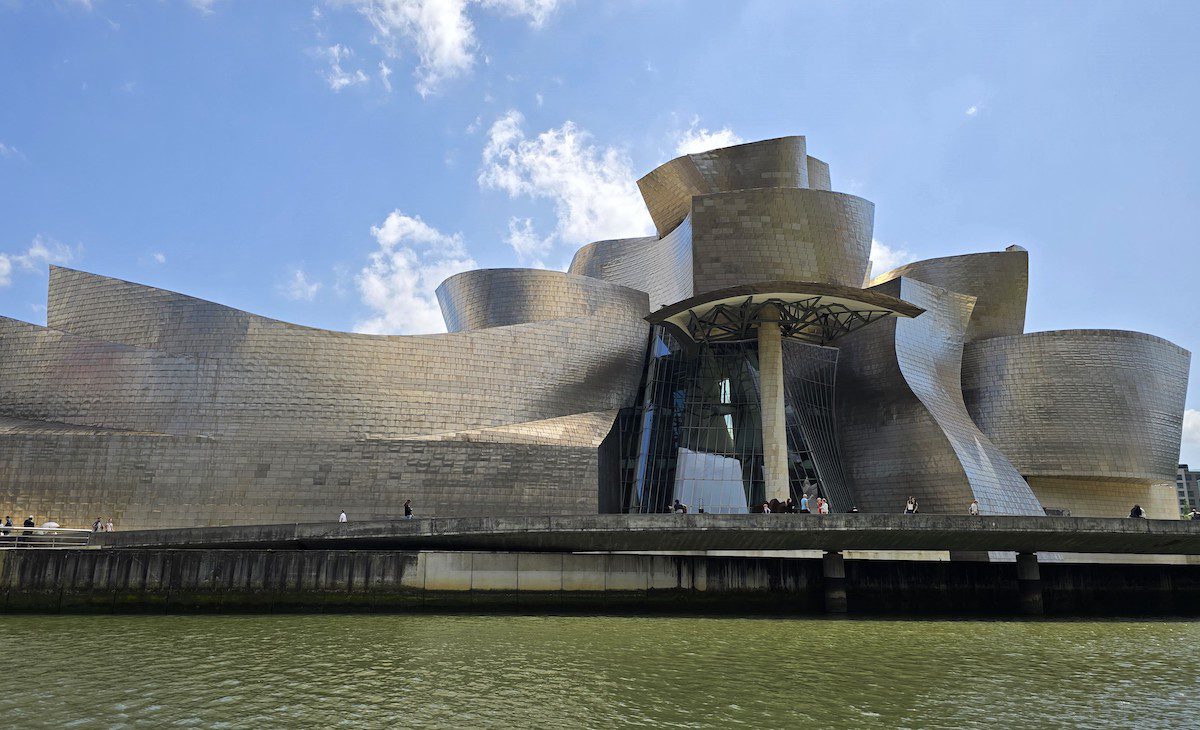
With curving lines and shimmering surfaces, the Guggenheim in Bilbao is an architectural masterpiece / Photo by Karen Gershowitz
Beyond the Guggenheim, Bilbao’s old town, known as Casco Viejo, retains its traditional charm. Here, I wandered through narrow streets lined with historic buildings, churches, and lively squares. The area is perfect for people-watching, especially during events like the UEFA Women’s Champion League final, which was played while I was there. It filled the streets with enthusiastic crowds, a vibrant atmosphere, and total joy when the Spanish team won.
I loved this town for many reasons, not least of which is that there are benches everywhere. When my back complained, I would sit on a bench or at a café (of which there are many) and people watch.
Read More: Five Must-Visit Spanish Towns
San Sebastian: Culinary Delights and Coastal Beauty
San Sebastian, or Donostia in Basque, is a smaller city, with a population of just under 200,000. The city mixes natural beauty with culinary excellence. It is situated on an inlet of the Atlantic along the northern Spanish coast, close to the Pyrenees Mountain range.
Known for its stunning beaches and vibrant food scene, San Sebastian is a must-visit destination in Basque Country. The city is a foodie’s paradise, where you can indulge in pintxos, the Basque version of tapas. Pintxos, small bites or snacks typically enjoyed in bars across Basque Country, are more than just a culinary tradition; they are a vital part of Basque culture and social life. Derived from the Spanish word “pincho,” meaning “spike,” these morsels are often skewered with a toothpick, hence their name.
Pintxos reflect the Basque emphasis on community and the joy of sharing food with others. People hop from bar to bar, sampling different pintxos along with a drink. This fosters a vibrant social atmosphere that is central to daily life in Basque towns and cities.
These small, flavorful bites are perfect for sampling a variety of local flavours. At one meal, I selected grilled squid, salmon with red peppercorns, a mushroom skewer, and a “gilda”—the most representative of all Basque pintxos—green olives, anchovies, and pickled guindilla peppers on a skewer. They were all delicious.
I love taking cooking classes wherever I travel. I took one at Mimo, a cooking school in San Sebastian. They offer hands-on classes where you can learn to prepare traditional Basque dishes. We first visited a market to understand the ingredients, then went to their kitchen. After donning an official apron and armed with a glass of local txakoli wine, we made leek, potato, and ham fritters, sautéed white asparagus on a bed of carrot puree, and fish with mushrooms and ham (they do like their pork). For dessert, we prepared a tart made with vanilla cream and covered in almonds, served with homemade ice cream. It was incredible fun and fabulous food.
San Sebastian’s natural beauty is best seen from the top of Monte Igueldo. A ride on the 100+-year-old funicular takes you to breathtaking views of the city and the coastline. Back in the city, there are three main beaches. La Concha (the Shell), the largest, is perfect for a leisurely stroll or sunbathing. Playa de la Zurriola is the surfing beach of San Sebastian, popular because of its bigger waves. Walking around the city, I saw many surfers, even on misty, cool days. The final beach is the more tranquil, family-friendly Ondarreta.
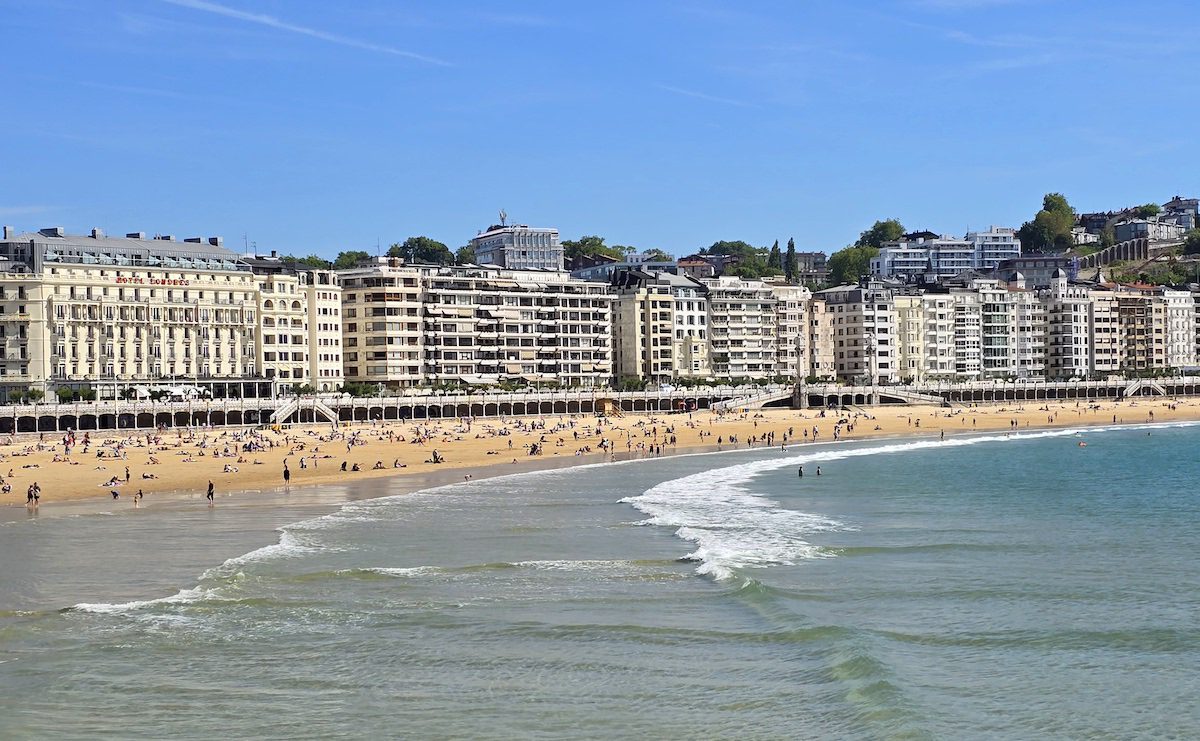
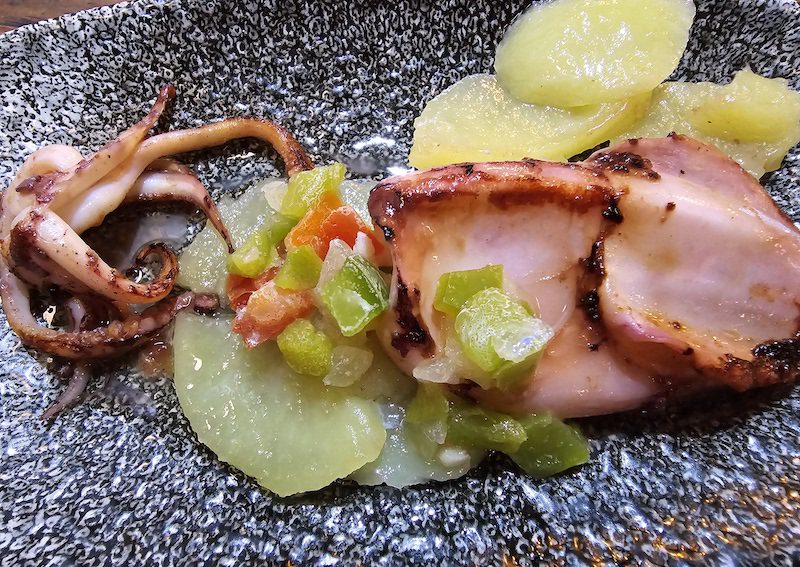
A plate of pintxos / Photo by Karen Gershowitz
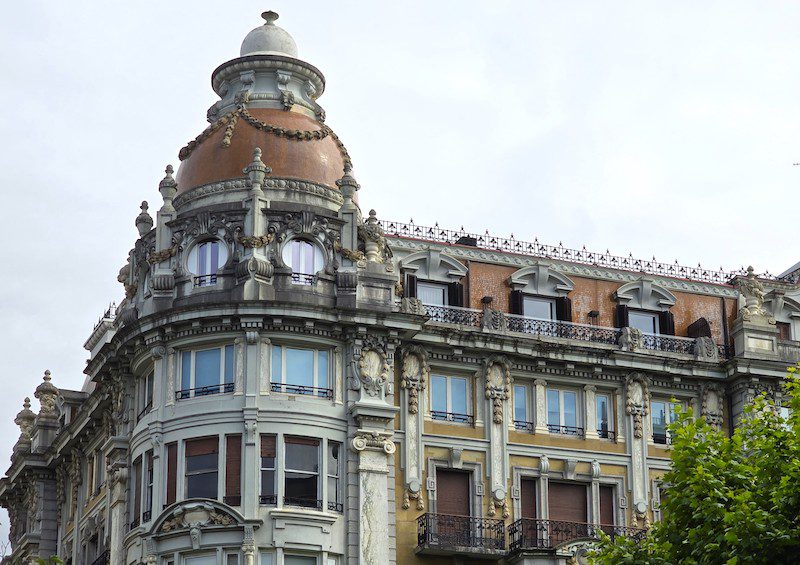
The legacy of Queen Maria Cristina is seen in the elegant French-style architecture that fills San Sebastian. She helped transform it into a fashionable summer resort during the nineteenth century. Her influence is evident in the many wrought-iron balconies and elaborate facades. Walking through the old part of the city, it is almost impossible to get lost. The streets follow a grid pattern and are bordered by the river, the sea, and a major boulevard.
A short way out of town, I visited an open-air art museum displaying the sculpture of local artist Eduardo Chillida. The setting was rolling hills, dotted with trees and sculpture. While I was walking around, the grass was getting mown; the scent added to my sense of well-being. Also on the property is a barn he converted into a work and exhibition space. The barn itself is a work of art. The supporting beams resemble tree trunks with upward-reaching branches. Sunlight poured in from skylights. Being inside had a magical sense of being open to the outside.
Cross-Border Basque Culture
Biarritz, a famous resort town of the wealthy, is in France, only about twenty miles from the border of Spain. It’s best known for its wild coastline and beautiful beaches with pounding waves that attract surfers. No one was surfing the day I visited; it was cloudy, gray, and poured on and off. Their music, dance, and food showcase the Basque influence, or so my guide said. Personally, the patisseries, chocolate shops, brasseries, tea shops and clothing stores all screamed France to me. There were no obvious signs of Basque culture, but when I read about it, there was confirmation that the locals consider themselves Basque first, French second.
Saint Jean de Luz seemed more in the Basque spirit. When we arrived, a Basque dance and music performance was taking place in the town square. I found the town charming, even with constant rain. Many streets were narrow, cobblestone and lined with quaint buildings. There were lively restaurants, bars, and shops. The Basques claim they invented macarons here. These aren’t the colorful sandwich looking macarons we’re accustomed to. Instead, they are brown, soft, and squishy. And for me, far too sweet. Saint Jean de Luz’s beach is expansive, with views of the surrounding mountains.
Basque traditions
The Basque region is rich in traditions, many of which are unique to this part of the world. Jai Alai is a fast-paced sport similar to racquetball or handball but is played with a curved handheld scoop. It’s worth a visit to watch the exciting game and the spectators.
Another traditional experience is visiting a Basque cider house. Alcoholic cider is a staple in Basque cuisine. They grow more than one hundred “official” varieties of apples. On arriving at the Petritegi Cider House, two men were pounding out rhythms on boards. A few days before, I’d heard the story of this rhythmic pounding. “You can stomp on grapes with your feet,” the guide said, “but it’s tough to do that with apples.” In the past, young men would pound the apples with poles until the juice separated from the pulp. That was a boring job, so they created tunes with their pounding. I’d never seen anything quite like it. Not the best music I’ve heard, but mesmerizing.
Dinner was calling, so I made my way inside the restaurant. It’s an enormous space. At communal tables, the waitstaff served platters of traditional foods—salt cod omelet, fried cod with peppers, an enormous T-bone steak, and for dessert, local cheese, quince jelly, walnuts in the shell and cookies. To get cider, everyone goes to the cider cellar, which holds more than a dozen ginormous barrels. The “cellar man” turns a spigot and out comes the cider, which you catch with your glass. You can go back as often as you like, sampling a variety of different ciders. It’s a delicious and unique experience.
For those who love the outdoors, Basque Country offers many choices. Hiking, rowing or kayaking, or taking a boat trip along the Basque coast are great ways to enjoy the region’s scenic landscapes.
The Basque region, with its unique blend of culture, cuisine, and natural beauty, charmed me. From the architecture and art of Bilbao to the culinary delights of San Sebastian and the cross-border charm of Biarritz and Saint Jean de Luz, there is something for every traveler.
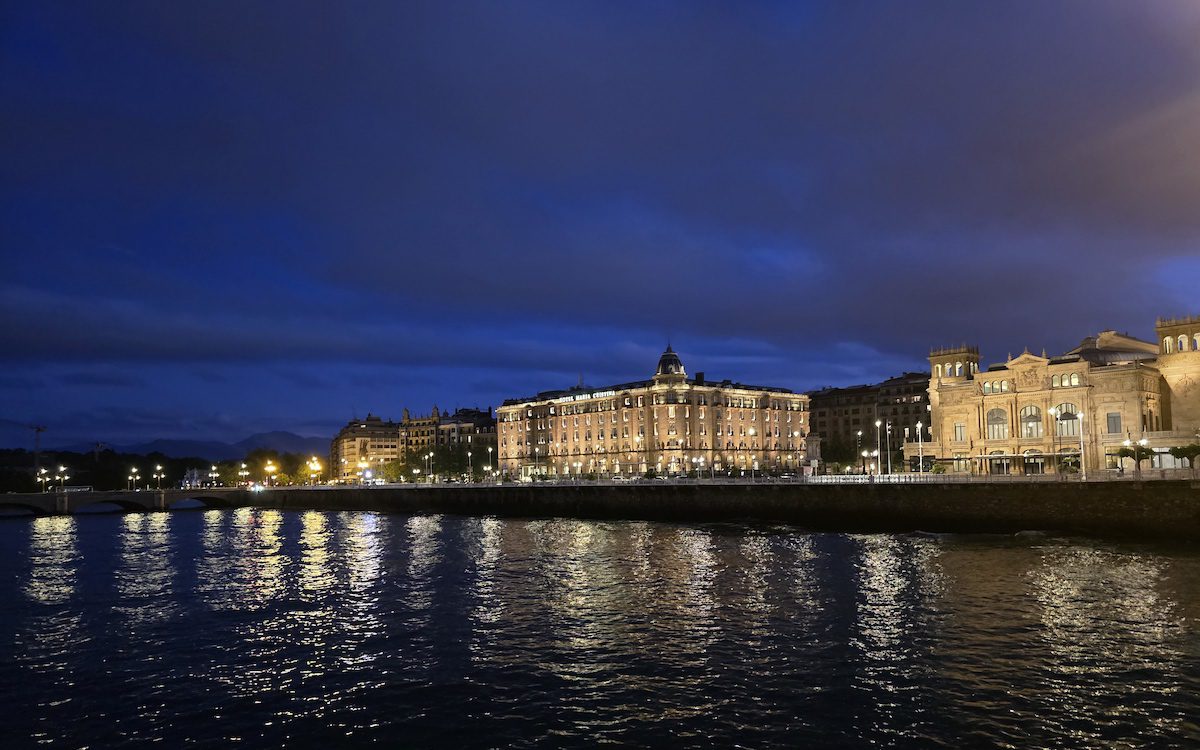
San Sebastian lit up at night / Photo by Karen Gershowitz
If you go to the Basque region
When to go: June to September are the warmest and driest months. The best time to go to the Basque Country is June or September, to miss summer holiday crowds
Transportation: There are no direct (non-stop) flights from North America to Bilbao, San Sebastian, or Biarritz at this time. You will need to change planes at a major hub to catch a flight to the Basque region. Bilbao (BIO) is the largest of the airports with the most frequent flights and carriers. Click here to check for flights.
If you are coming from another major city in Spain, like Madrid or Barcelona, consider taking a train. Those cities are connected to the Basque region by high-speed and regional trains operated by Renfe, Spain’s national railway company. The journey from Madrid to Bilbao takes about 4-5 hours, depending on the service.
In France, the Basque region is accessible via the French national railway service, SNCF. Direct trains run from Paris to Hendaye (on the French-Spanish border) and Biarritz. From Paris, the journey to Hendaye typically takes around 4-5 hours on the high-speed TGV.
To get from Bilbao to San Sebastian there are frequent and comfortable buses that are inexpensive. There are also many buses to Biarritz and San Jean de Luz.
Taxis are readily available but can be expensive. You need to go to a taxi stand to get one or have your hotel call one for you.
Renting a car is an option for exploring rural areas and smaller towns. Be aware of narrow roads and limited parking in city centers.
Accommodation: Book accommodations well in advance, especially during peak tourist seasons and major events. Consider staying in apartments which can easily be found through Airbnb. Find a place to stay on the Women’s Travel Directory here.
Local Etiquette: Dinner time is usually later than in other parts of Europe, with restaurants opening around 8 PM. An alternative is to dine on pintxos, which are available at all hours.
Tipping is not obligatory but appreciated. Leaving a small amount (5-10%) or rounding up the bill is customary.
Weather: The Basque region has a mild climate but can be rainy, especially in coastal areas. Pack layers and a waterproof jacket.
Connectivity: Free Wi-Fi is common in hotels and many public places. Otherwise, consider an eSIM like Airalo to stay connected on the go.
For more information, check out the official Basque Tourism website here.
More to Discover From Spain
Where to Stay in Barcelona, Spain: Recommendations From Solo Women
Women share their recommendations on where to stay in Barcelona, Spain, including hotels, hostels and affordable accommodations.
Transforming an Abandoned Quarry Into a Vineyard: A Story of Sustainability in Mallorca
On the wine-producing island of Mallorca, Spain, entrepreneur Virginia Pones is bringing an abandoned quarry back to life as a winery, reviving her husband’s family business.
Riding Solo: Active Travel for Women Over 50
For women over 50 who want to stay active while travelling, group cycling trips offer a way to make connections while seeing the world.

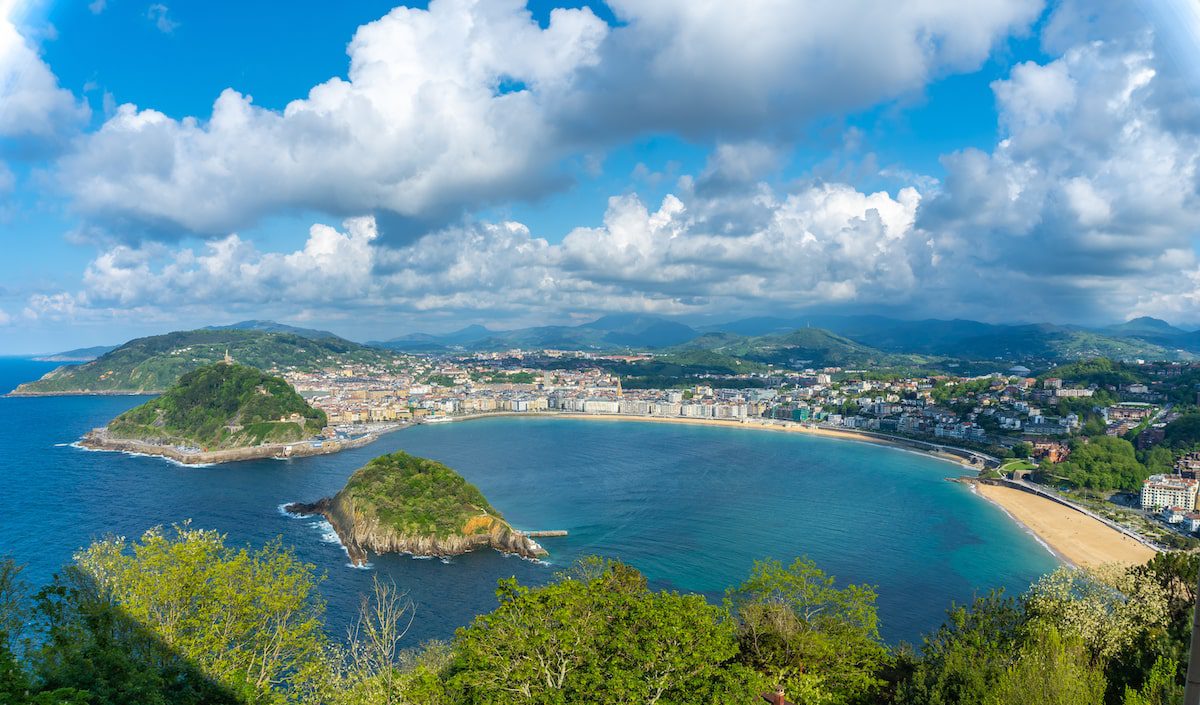



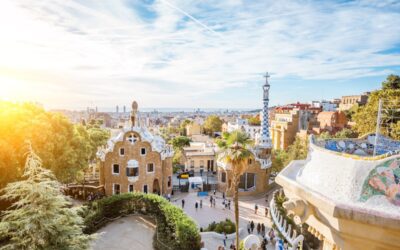
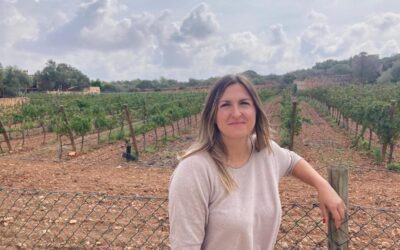
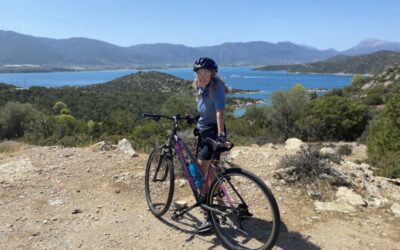
My last trip was to Bilbao as it had been on my bucket list for years, even since Gerry’s masterful architecture museum was built. I was all set to travel and then I fell at the gym and sustained a concussion. Given that I had 4 flights in 2 weeks, my doctor advised I cancel the trip, so to my dismay, I did. Sadly, we then had to deal with Covid. I’ve not traveled since.